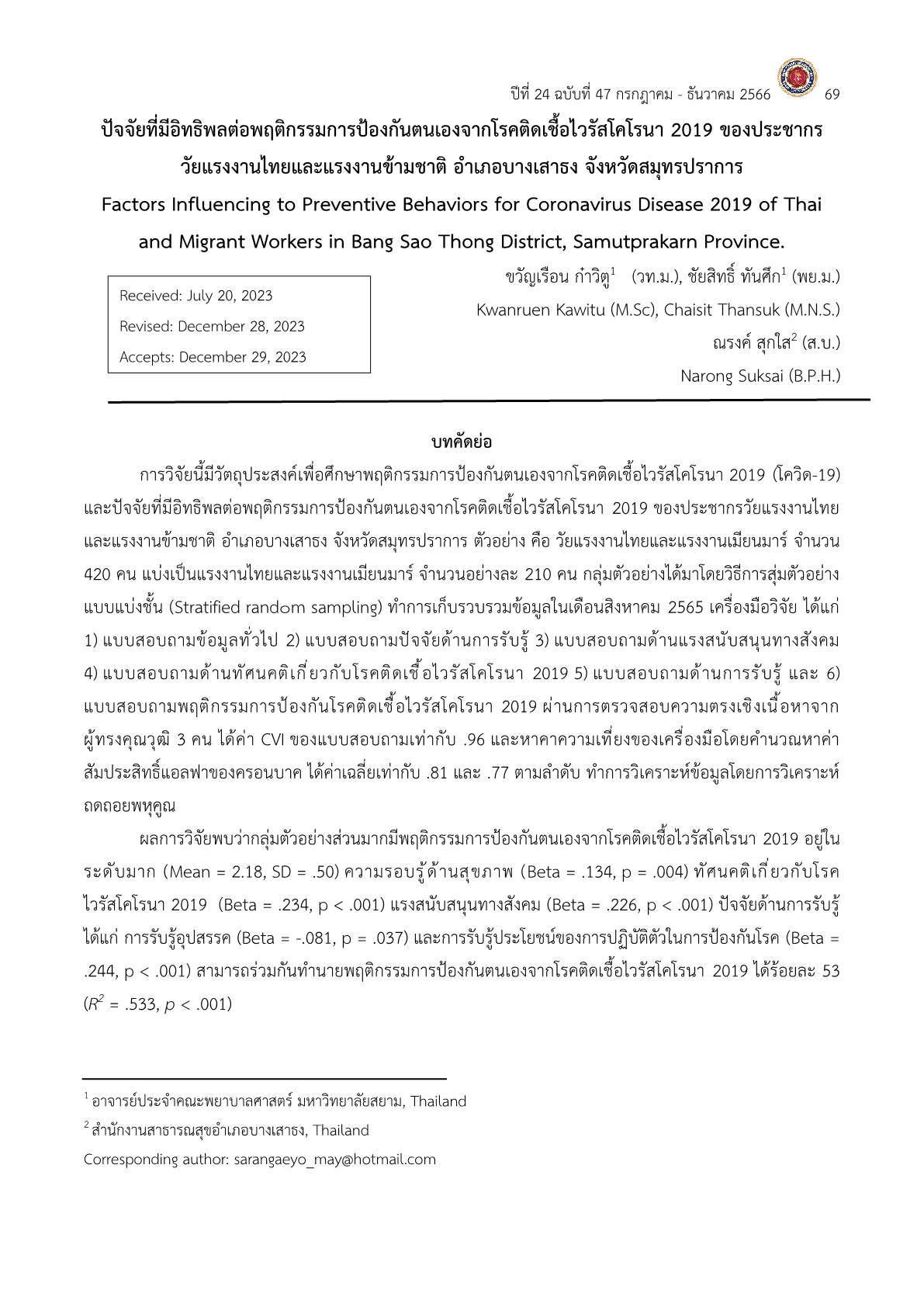ปัจจัยที่มีอิทธิพลต่อพฤติกรรมการป้องกันตนเองจากโรคติดเชื้อไวรัสโคโรนา 2019 ของประชากรวัยแรงงานไทยและแรงงานข้ามชาติ อำเภอบางเสาธง จังหวัดสมุทรปราการ
คำสำคัญ:
ปัจจัยที่มีอิทธิพล, พฤติกรรมการป้องกันตนเอง, โรคติดเชื้อไวรัสโคโรนา 2019, ประชากรวัยแรงงานบทคัดย่อ
การวิจัยนี้มีวัตถุประสงค์เพื่อศึกษาพฤติกรรมการป้องกันตนเองจากโรคติดเชื้อไวรัสโคโรนา 2019 (โควิด-19) และปัจจัยที่มีอิทธิพลต่อพฤติกรรมการป้องกันตนเองจากโรคติดเชื้อไวรัสโคโรนา 2019 ของประชากรวัยแรงงานไทยและแรงงานข้ามชาติ อำเภอบางเสาธง จังหวัดสมุทรปราการ ตัวอย่าง คือ วัยแรงงานไทยและแรงงานเมียนมาร์ จำนวน 420 คน แบ่งเป็นแรงงานไทยและแรงงานเมียนมาร์ จำนวนอย่างละ 210 คน กลุ่มตัวอย่างได้มาโดยวิธีการสุ่มตัวอย่างแบบแบ่งชั้น (Stratified rand๐m sampling) ทำการเก็บรวบรวมข้อมูลในเดือนสิงหาคม 2565 เครื่องมือวิจัย ได้แก่ 1) แบบสอบถามข้อมูลทั่วไป 2) แบบสอบถามปัจจัยด้านการรับรู้ 3) แบบสอบถามด้านแรงสนับสนุนทางสังคม 4) แบบสอบถามด้านทัศนคติเกี่ยวกับโรคติดเชื้อไวรัสโคโรนา 2019 5) แบบสอบถามด้านการรับรู้ และ 6) แบบสอบถามพฤติกรรมการป้องกันโรคติดเชื้อไวรัสโคโรนา 2019 ผ่านการตรวจสอบความตรงเชิงเนื้อหาจากผู้ทรงคุณวุฒิ 3 คน ได้ค่า CVI ของแบบสอบถามเท่ากับ .96 และหาคาความเที่ยงของเครื่องมือโดยคำนวณหาค่าสัมประสิทธิ์แอลฟาของครอนบาค ได้ค่าเฉลี่ยเท่ากับ .81 และ .77 ตามลำดับ ทำการวิเคราะห์ข้อมูลโดยการวิเคราะห์ถดถอยพหุคูณ
ผลการวิจัยพบว่ากลุ่มตัวอย่างส่วนมากมีพฤติกรรมการป้องกันตนเองจากโรคติดเชื้อไวรัสโคโรนา 2019 อยู่ในระดับมาก (Mean = 2.18, SD = .50) ความรอบรู้ด้านสุขภาพ (Beta = .134, p = .004) ทัศนคติเกี่ยวกับโรคติดเชื้อไวรัสโคโรนา 2019 (Beta = .234, p < .001) แรงสนับสนุนทางสังคม (Beta = .226, p < .001) ปัจจัยด้านการรับรู้ ได้แก่ การรับรู้อุปสรรค (Beta = -.081, p = .037) และการรับรู้ประโยชน์ของการปฏิบัติตัวในการป้องกันโรค (Beta = .244, p < .001) สามารถร่วมกันทำนายพฤติกรรมการป้องกันตนเองจากโรคติดเชื้อไวรัสโคโรนา 2019 ได้ร้อยละ 53 (R2 = .533, p < .001)
ผลการศึกษาสามารถใช้เป็นแนวทางในการกำหนดแบบแผนหรือรูปแบบกิจกรรมที่สอดคล้องกับประชาชน เช่น กิจกรรมการให้ความรู้กับประชาชน ในการเตรียมการรับมือกับการเกิดอุบัติการณ์ใหม่ในอนาคต และช่วยเตรียมแรงงานให้พร้อมอยู่ในภายใต้ชีวิตวิถีใหม่
เอกสารอ้างอิง
ขนิษฐา ชื่นใจ และบุฏกา ปัณฑุรอัมพร. (2564). ปัจจัยที่ส่งผลต่อการตัดสินใจฉีดวัคซีนป้องกันโคโรนาไวรัส (Covid-19)ของประชากรในกรุงเทพมหานคร.สืบค้นจาก https://mmm.ru.ac.th/MMM/IS/twin9/6214154037.pdf
ชินาธิป นิสสะ. (2564). ความสัมพันธ์ระหว่าง ความเชื่อด้านสุขภาพกับพฤติกรรมการป้องกันโรคหลอดเลือดหัวใจของผู้ที่มีภาวะเมตาบอลิกซินโดรม. วารสารวิจัยสาธารณสุขศาสตร์ มหาวิทยาลัยราชภัฏอุบลราชธานี. 10(2), 138–147.
เชาวลิต เลื่อนลอย. (2565).ปัจจัยที่มีผลต่อพฤติกรรมการป้องกันโรคติดเชื้อไวรัสโคโรนา 2019 ของประชาชนอำเภอศรีนคร จังหวัดสุโขทัย. วารสารสาธารณสุขและสุขภาพศึกษา. 2(1). 18-33.
ญาดา เรียมริมมะดัน, และศิรินันท์ คำสีม. (2561). ปัจจัยที่มีความสัมพันธ์ต่อพฤติกรรมการสร้างเสริมสุขภาพของแรงงานต่างด้าว ในจังหวัดฉะเชิงเทรา. วารสาร มฉก วิชาการ. 21(42). 79-91.
ประกาย จิโรจน์กุล. (2556). แนวคิด ทฤษฎีการสร้างเสริมสุขภาพ และการนำมาใช้. นนทบุรี: โครงการสวัสดิการวิชาการ สถาบันพระบรมราชนก.
เพ็ญแข ดิษฐบรรจง, นงณภัทร รุ่งเนย, อัจฉรา สุขสำราญ และฉัตรทอง จารุพิสิฐไพบูลย์. (2565). ปัจจัยทํานายพฤติกรรมการป้องกันโรคโควิด-19 ของนักเรียนชั้นประถมศึกษาตอนปลาย. วารสารสุขภาพและการศึกษาพยาบาล. 28(2) 1-17.
ยุซรอ เล๊าะแม, มยุรี ยีปาโล๊ะ และเขมพัทธ์ ขจรกิตติยา. (2564). ปัจจัยทำนายพฤติกรรมการป้องกันโรคโควิด-19 ของผู้ปกครองเด็กวัยก่อนเรียน. วารสารวิทยาลัยพยาบาลพระจอมเกล้า จังหวัดเพชรบุรี. 5(1). 12-25
ยุพา วงศ์ไชย และระพีพรรณ คําหอม. (2554). สถานภาพและบทบาทการดำเนินการส่งเสริมสุขภาพภาคเอกชนในประเทศไทย. คลังข้อมูลและความรู้ระบบสุขภาพ สถาบันวิจัยระบบสาธารณสุข (สวรส.). สืบค้นจากhttps://kb.hsri.or.th/dspace/ handle/11228/1994?localeattribute=th
วัชราพร เชยสุวรรณ. (2560). ความรอบรู้ด้านสุขภาพ: แนวคิดและการประยุกต์สู่การปฏิบัติการพยาบาล. วารสารแพทย์นาวี. 44(3). 183-197.
วิญญ์ทัญญู บุญทัน, พัชราภรณ์ ไหวคิด, วิภาพร สร้อยแสง, ชุติมา สร้อยนาค, ปริศนา อัครธนพล, และ จริยาวัตร คมพยัคฆ์. (2563). ปัจจัยที่มีอิทธิพลต่อพฤติกรรมการสร้างเสริมสุขภาพในการป้องกันการติดเชื้อไวรัสโคโรนา 2019 (โควิด -19) ของผู้สูงอายุ. วารสารพยาบาลตำรวจ. 12(2). 323-337.
ศิรดา เขมานิฏฐาไท. สถานการณ์แรงงานข้ามชาติและการข้ามพรมแดนในช่วงการระบาดของโควิด-19. สืบค้นจาก https://mwgthailand.org/th/press/1639870217
สถานการณ์ด้านแรงงานภายในจังหวัดสมุทรปราการ ไตรมาส 3 ปี 2564 .สืบค้นเมื่อ 30 พ.ค. 65, จาก https://samutprakan.mol.go.th/news/สถานการณ์ด้านแรงงานภายในจังหวัดสมุทรปราการ ไตรมาส-3-ปี-2564-กรกฎาคม-กันยายน-2554
สถาบันวิจัยระบบสาธารณสุข.(2541). นิยามศัพท์ส่งเสริมสุขภาพ (พิมพ์ครั้งที่ 2). กรุงเทพฯ: บริษัท ดีไซร์จำกัด.
สำนักงานข่าว กรมประชาสัมพันธ์. สืบค้นจาก https:// thainews. prd.go.th/th/news/detail/TCATG230506185137321
สำนักสารสนเทศ สำนักงานปลัดกระทรวงสาธารณะสุข. สืบค้นจากhttps://pr.moph.go.th/?url=pr/detail/2/04/174113
สุภาภรณ์ วงธิ. (2564). ปัจจัยที่ส่งผลต่อพฤติกรรมการป้องกันโรคติดเชื้อไวรัสโคโรนา 2019 ของอาสาสมัครสาธารณสุขประจำหมู่บ้าน จังหวัดสุโขทัย. (วิทยานิพนธ์ปริญญามหาบัณฑิต). มหาวิทยาลัยนเรศวร, พิษณุโลก.
สุมิตรา ชูแก้ว. (2555). ความรู้ ทัศนคติ และการปฏิบัติตามการรับรู้ของพยาบาลในการช่วยเหลือและสร้างเสริมสุขภาพของญาติผู้ดูแลผู้ป่วยโรคเรื้อรัง. รามาธิบดีพยาบาลสาร. 18(2). 249-258.
สุรัยยา หมานมานะ, โสภณ เอี่ยมศิริถาวร และสุมนมาลย์ อุทยมกุล. (2563).โรคติดเชื้อไวรัสโคโรนา 2019 (COVID-19).
วารสารสถาบันบำราศนราดู. 14(2). 124-133.
อภิวดี อินทเจริญ, คันธมาทน์ กาญจนภูมิ, กัลยา ตันสกุล และ สุวรรณา ปัตตะพัฒน์. (2564). ปัจจัยที่มีอิทธิพลต่อพฤติกรรมการป้องกันโรคติดเชื้อไวรัสโคโรนา 2019 ของประชาชน ในเขต เทศบาลเมืองคอหงส์ จังหวัดสงขลา.วารสารสภาการสาธารณสุขชุมชน. 3(2). 19-30.
อุษณียาภรณ์ จันทร, พจนารถ สารพัด และศิริยุพา สนั่นเรืองศักดิ์. (2566). ปัจจัยทำนายพฤติกรรมการป้องกันโรคติดเชื้อไวรัสโคโรนา 2019 ในวัยรุ่นตอนต้น. วารสารวิทยาลัยพยาบาลบรมราชชนนี สุพรรณบุรี. 6(2). 82-89.
Becker, M. H. (1974). The health belief model and personal health behavior. Health education monographs, 2,324-473.
Bloom, B. S. (1964). Taxonomy of education objective: The classification of educational goals: Handbook II: Affective domain. New York: David Mckay.
Department Of Disease Control. (2022). Retrieved form https://ddc.moph.go.th/covid19dashboard/.
Krejcie, R.V., & Morgan, D.W. (1970). Determination sample size for research activities. Education and Psychology Measurement, 30(3), p 607-610.
Nutbeam D. (2000). Health Literacy as a public health goal: a challenge for contemporary health education and communication strategies into the 21st century. Health Promotion International, 15(3), 259-267.

ดาวน์โหลด
เผยแพร่แล้ว
รูปแบบการอ้างอิง
ฉบับ
ประเภทบทความ
สัญญาอนุญาต
ลิขสิทธิ์ (c) 2023 วารสารพยาบาลศาสตร์ มหาวิทยาลัยสยาม

อนุญาตภายใต้เงื่อนไข Creative Commons Attribution-NonCommercial-NoDerivatives 4.0 International License.
เนื้อหาและข้อมูลที่เผยแพร่ในวารสารพยาบาลศาสตร์ มหาวิทยาลัยสยามถือเป็นข้อคิดเห็นและความรับผิดชอบของผู้นิพนธ์บทความโดยตรง
บทความ เนื้อหา ข้อมูล รูปภาพ ฯลฯ ที่ได้รับการเผยแพร่ในวารสารพยาบาลศาสตร์ มหาวิทยาลัยสยาม ถือเป็นลิขสิทธิ์ของวารสารพยาบาลศาสตร์ มหาวิทยาลัยสยาม หากบุคคลหรือหน่วยงานใดต้องการนำทั้งหมดหรือส่วนหนึ่งส่วนใดไปเผยแพร่หรือเพื่อกระทำการใด ๆ จะต้องอ้างอิงวารสารพยาบาลศาสตร์ มหาวิทยาลัยสยามทุกครั้ง


